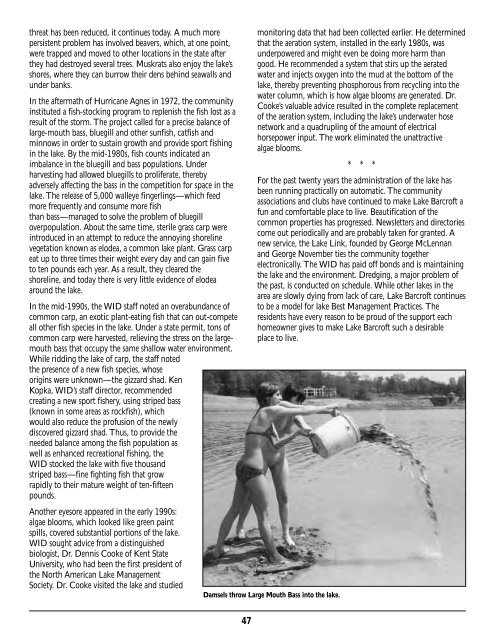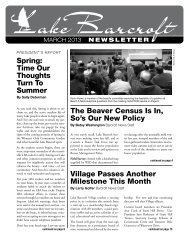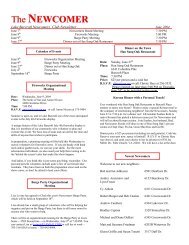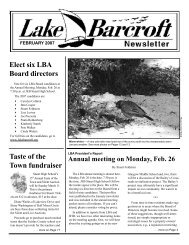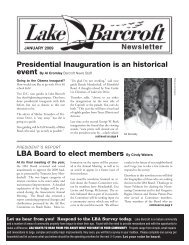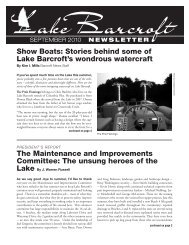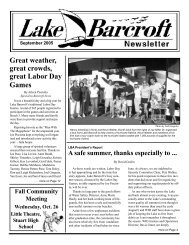Lake Barcroft History Book
Lake Barcroft History Book
Lake Barcroft History Book
Create successful ePaper yourself
Turn your PDF publications into a flip-book with our unique Google optimized e-Paper software.
threat has been reduced, it continues today. A much more<br />
persistent problem has involved beavers, which, at one point,<br />
were trapped and moved to other locations in the state after<br />
they had destroyed several trees. Muskrats also enjoy the lake’s<br />
shores, where they can burrow their dens behind seawalls and<br />
under banks.<br />
In the aftermath of Hurricane Agnes in 1972, the community<br />
instituted a fish-stocking program to replenish the fish lost as a<br />
result of the storm. The project called for a precise balance of<br />
large-mouth bass, bluegill and other sunfish, catfish and<br />
minnows in order to sustain growth and provide sport fishing<br />
in the lake. By the mid-1980s, fish counts indicated an<br />
imbalance in the bluegill and bass populations. Under<br />
harvesting had allowed bluegills to proliferate, thereby<br />
adversely affecting the bass in the competition for space in the<br />
lake. The release of 5,000 walleye fingerlings—which feed<br />
more frequently and consume more fish<br />
than bass—managed to solve the problem of bluegill<br />
overpopulation. About the same time, sterile grass carp were<br />
introduced in an attempt to reduce the annoying shoreline<br />
vegetation known as elodea, a common lake plant. Grass carp<br />
eat up to three times their weight every day and can gain five<br />
to ten pounds each year. As a result, they cleared the<br />
shoreline, and today there is very little evidence of elodea<br />
around the lake.<br />
In the mid-1990s, the WID staff noted an overabundance of<br />
common carp, an exotic plant-eating fish that can out-compete<br />
all other fish species in the lake. Under a state permit, tons of<br />
common carp were harvested, relieving the stress on the largemouth<br />
bass that occupy the same shallow water environment.<br />
While ridding the lake of carp, the staff noted<br />
the presence of a new fish species, whose<br />
origins were unknown—the gizzard shad. Ken<br />
Kopka, WID’s staff director, recommended<br />
creating a new sport fishery, using striped bass<br />
(known in some areas as rockfish), which<br />
would also reduce the profusion of the newly<br />
discovered gizzard shad. Thus, to provide the<br />
needed balance among the fish population as<br />
well as enhanced recreational fishing, the<br />
WID stocked the lake with five thousand<br />
striped bass—fine fighting fish that grow<br />
rapidly to their mature weight of ten-fifteen<br />
pounds.<br />
Another eyesore appeared in the early 1990s:<br />
algae blooms, which looked like green paint<br />
spills, covered substantial portions of the lake.<br />
WID sought advice from a distinguished<br />
biologist, Dr. Dennis Cooke of Kent State<br />
University, who had been the first president of<br />
the North American <strong>Lake</strong> Management<br />
Society. Dr. Cooke visited the lake and studied<br />
47<br />
monitoring data that had been collected earlier. He determined<br />
that the aeration system, installed in the early 1980s, was<br />
underpowered and might even be doing more harm than<br />
good. He recommended a system that stirs up the aerated<br />
water and injects oxygen into the mud at the bottom of the<br />
lake, thereby preventing phosphorous from recycling into the<br />
water column, which is how algae blooms are generated. Dr.<br />
Cooke’s valuable advice resulted in the complete replacement<br />
of the aeration system, including the lake’s underwater hose<br />
network and a quadrupling of the amount of electrical<br />
horsepower input. The work eliminated the unattractive<br />
algae blooms.<br />
* * *<br />
For the past twenty years the administration of the lake has<br />
been running practically on automatic. The community<br />
associations and clubs have continued to make <strong>Lake</strong> <strong>Barcroft</strong> a<br />
fun and comfortable place to live. Beautification of the<br />
common properties has progressed. Newsletters and directories<br />
come out periodically and are probably taken for granted. A<br />
new service, the <strong>Lake</strong> Link, founded by George McLennan<br />
and George November ties the community together<br />
electronically. The WID has paid off bonds and is maintaining<br />
the lake and the environment. Dredging, a major problem of<br />
the past, is conducted on schedule. While other lakes in the<br />
area are slowly dying from lack of care, <strong>Lake</strong> <strong>Barcroft</strong> continues<br />
to be a model for lake Best Management Practices. The<br />
residents have every reason to be proud of the support each<br />
homeowner gives to make <strong>Lake</strong> <strong>Barcroft</strong> such a desirable<br />
place to live.<br />
Damsels throw Large Mouth Bass into the lake.


